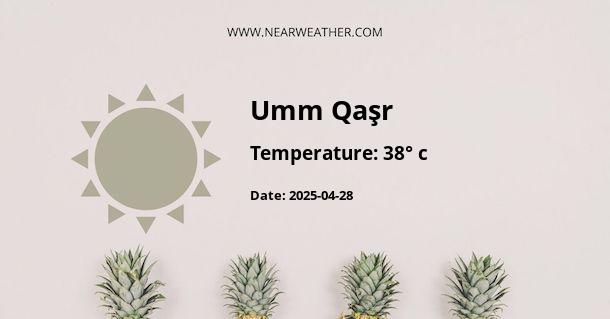Overview of Umm Qasr, Iraq
Umm Qasr, a city located in the southernmost district of Iraq, is a fascinating region with a climate that significantly influences its daily life, as well as its economic and agricultural activities. Known as the largest port in Iraq, it lies on the western edge of the Al-Faw Peninsula near the Shatt Al-Arab waterway, which connects to the Persian Gulf.
Climate of Umm Qasr
Umm Qasr is located in a desert region and thus experiences an arid climate. The Köppen-Geiger climate classification typically classifies it as BWh, which indicates a hot desert climate. This climate category is characterized by minimal rainfall and high temperatures.
Temperature
In Umm Qasr, the average temperature year-round ranges from 14°C to 41°C. The warm season generally lasts from May to October, with an average daily high temperature above 37°C. The hottest months are July, August, and September.
The coldest season in Umm Qasr is from November to March, with an average daily high temperature below 23°C. The coldest months are typically January and February.
Rainfall
Umm Qasr experiences minimal rainfall throughout the year, with the annual precipitation averaging around 100mm. The rainy period generally extends from November to April, with February being the wettest month.
Weather Patterns in Umm Qasr
The weather patterns in Umm Qasr are largely influenced by its geographical location and the prevailing global climate phenomena.
Wind Patterns
The wind in Umm Qasr typically comes from the north, with a peak average speed in the spring months. The windiest month is typically June, followed by May and July.
Humidity
Due to its proximity to the Persian Gulf, Umm Qasr experiences higher humidity than other desert locations. The relative humidity typically ranges from about 30% in the hot and dry summer months to over 80% during the cooler and more humid winter months.
Heat Index
Due to the high temperatures and humidity levels, the perceived temperature, or heat index, in Umm Qasr can be significantly higher than the actual temperature, particularly during the summer months.
Impacts of Climate and Weather on Umm Qasr
The climate and weather patterns in Umm Qasr significantly impact the city's socio-economic activities. The extreme heat and dryness limit agricultural activities to a great extent. However, the city's location along the Persian Gulf makes it an important location for maritime activities and trade.
The port of Umm Qasr is a vital infrastructure that supports the Iraqi economy. Its operations, however, can be affected by extreme weather conditions such as high winds and high heat index values.
In conclusion, Umm Qasr's desert climate, characterized by high temperatures and minimal rainfall, coupled with its strategic location along the Persian Gulf, shapes the city's daily life and socio-economic activities. Understanding these weather patterns and their impacts is crucial for planning and development in the region.
A - Umm Qaşr's Latitude is 30.040541 & Longitude is 47.916771.
A - Weather in Umm Qaşr is 20° today.
A - Climate Conditions in Umm Qaşr shows clear sky today.
A - Humidity in Umm Qaşr is 34% today.
A - Wind speed in Umm Qaşr is 18.25 km/h, flowing at 294° wind direction. today.
